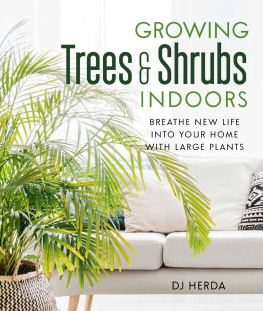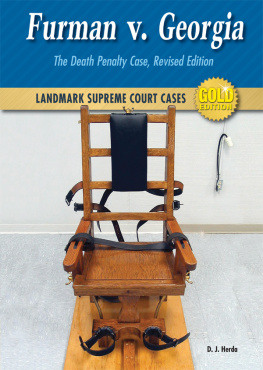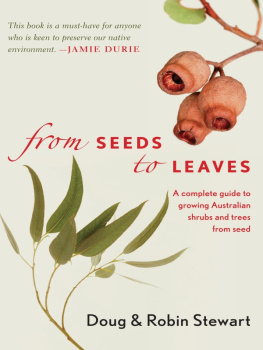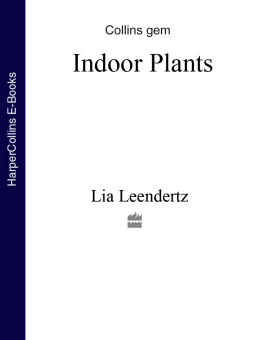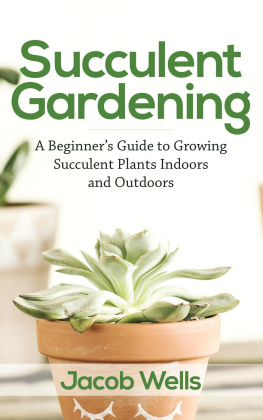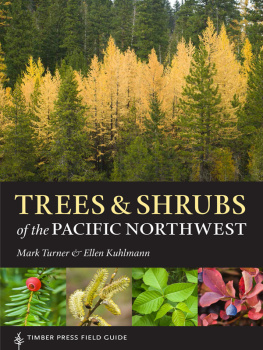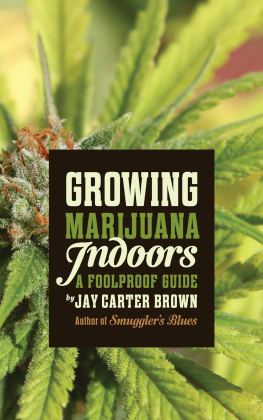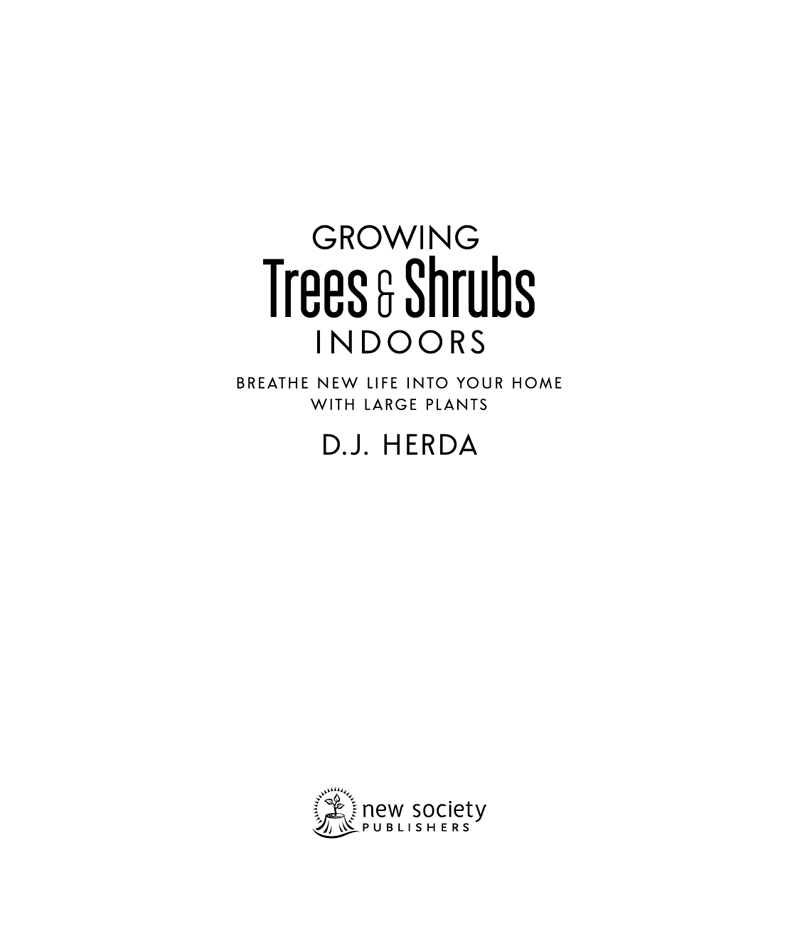Praise for
Growing Trees and Shrubs Indoors
D. J. Herda brings all his talents as a writer and his personal experiences as a gardener to bear in this fascinating, encyclopedic compendium dealing with the nature and care of trees and shrubs. It would not surprise me to learn that many readers of this book might later choose to turn the interiors of their once barren homes into lush forests and woodlands. My guess is that any lover of nature would enjoy owning this book.
Arnold M. Ludwig, author, The Price of Greatness and King of the Mountain: The Nature of Political Leadership
This is a great read! If, like me, you think plants are just decorations, think again. D.J. explains that they are much, much more than that. Just reading the preface transformed my understanding of, and respect for, indoor plants. As a behavioural psychologist, I am well aware of the benefits plants can have on our minds, but I was less aware of the impact they have on our health. In summary, this book is an enlightening journey through the world of indoor plants. Clearly written and beautifully illustrated. Even if you dont have any interest in indoor plants you should definitely read Growing Trees and Shrubs Indoors. Its a real eye-opener!
Phillip Adcock, commercial psychologist, and author, Master Your Brain
D.J. Herdas book is a comprehensive view into not only how to grow trees and shrubs in your home or office, but also why. Sure, many of us know the health advantages of having indoor plants air purification, better productivity, and an increase in overall mood yet we generally dont look beyond buying the basic houseplants. D.J. explains the benefits of going big and then tells us how to do it, from what kinds of trees to buy to how to take care of them. He covers everything from watering needs and light requirements to propagation to keep costs down, all in an effort to help you create a verdant home that has the health benefits of being outside.
Deanna Duke, author, The Non-Toxic Avenger: What You Dont Know Cant Hurt You
When I was young (I am 72 years old now) I tried growing a couple of dwarf shrubs inside my apartment. It only took a couple of weeks before the leaves turned yellow, and eventually the plant died. If I only knew then what I have learned from D. J. Herdas new book, I would have been called Dr. Green Thumb instead of Dr. Death. And who would have thought that these trees and shrubs could improve my health as well as the health of my home environment? Well-written, entertaining, and loaded with useful information!
Dr. Al Danenberg, periodontist, Certified Functional Medicine Practitioner, Certified Primal Health Coach
This book explains which plants are the most beneficial for a healthy indoor environment and how to use these natural air purifiers so that they are attractive and thriving contributors to any household. The author distills a lifetime of plant experience into easy-to-follow instruction on how to select, combine, shape, and maintain indoor trees and shrubs, giving an amateur like me the confidence to green my home for health. The annotated list, complete with photos, is especially helpful to those of us who cant remember plant names and dont speak Latin.
Paula Baker-LaPorte, FAIA, BBNC, and co-author, Prescriptions for a Healthy House
Copyright 2019 by D.J. Herda.
All rights reserved.
Cover design by Diane McIntosh.
Cover photo: iStock
Background image: AdobeStock_90796513
Printed in Canada. First printing October 2019.
Inquiries regarding requests to reprint all or part of Growing Trees and Shrubs Indoors should be addressed to New Society Publishers at the address below. To order directly from the publishers, please call toll-free (North America) 1-800-567-6772, or order online at www.newsociety.com
Any other inquiries can be directed by mail to:
New Society Publishers
P.O. Box 189, Gabriola Island, BC V0R 1X0, Canada
(250) 247-9737
LIBRARY AND ARCHIVES CANADA CATALOGUING IN PUBLICATION
Title: Growing trees & shrubs indoors : breathe new life into your home with large plants / D.J. Herda.
Other titles: Growing trees and shrubs indoors
Names: Herda, D. J., 1948- author.
Description: Includes bibliographical references and index.
Identifiers: Canadiana (print) 20190133384 | Canadiana (ebook) 20190133392 | ISBN 9780865719125 (softcover) | ISBN 9781550927054 (PDF) | ISBN 9781771423014 (EPUB)
Subjects: LCSH: Trees. | LCSH: Shrubs. | LCSH: House plants. | LCSH: Indoor gardening. | LCSH: Indoor air pollutionPrevention.
Classification: LCC SB435.5 .H47 2019 | DDC 635.9/65dc23

New Society Publishers mission is to publish books that contribute in fundamental ways to building an ecologically sustainable and just society, and to do so with the least possible impact on the environment, in a manner that models this vision.

Contents
Preface
T REES AND SHRUBS. Dozens of them. Thousands. Millions. Trillions! They dominate the landscape in all four corners of the world. They adapt to the harshest climates and the most grueling conditions. They generate oxygen and remove carbon dioxide from the atmosphere around us. They provide shade in the summer and a windbreak in the winter. They cut heating and cooling costs for our homes. They may even produce beautiful, aromatic flowers and edible, healthful fruit and nuts!
But why on Earth would anyone want to grow trees and shrubs indoors? They are, after all, the mega-monsters of the plant world. Theyre huge and gobble up tons of space. Theyre difficult to grow under the best of conditions. And theyre nearly impossible to move around.
Or are they?
Actually, trees and shrubs make great indoor companions for human domiciles. They are masters of environmental cleansing, which is extraordinarily good news since numerous studies show that the most polluted air we breathe comes from inside our own homes not out. The EPA estimates that indoor pollution levels are between two-to-five times higher than they are outside. Some of the specific pollutants you breathe in can be as much as 100 times more concentrated indoors!
Both the National Cancer Institute (NCI) and the Centers for Disease Control and Prevention (CDC) have established that 80 percent of all cancers may be attributed to factors not from your genetic makeup or your diet but from your environment. The sources of indoor pollution are a combination of interactions between buildings, their occupants, the climate, construction materials, furnishings, and specific contaminants. Among the causes are hundreds of different harmful volatile organic compounds (VOCs) that are your homes usual suspects. These include asbestos, bacteria, viruses, building materials, painting and decorating products, carbon monoxide, carpets, cleaning supplies and household chemicals, cockroaches, dust mites, dust, formaldehyde, lead, pet dander, radon, secondhand smoke, fire retardants, and other miscellany.
VOCs are a specific and dangerous type of pollution emitted from the use of everyday products such as aerosol sprays, cleaning supplies, wood preservatives, hobby supplies, and pressed wood products commonly used in furniture and building materials. Some of the more familiar names of these VOCs are benzene, formaldehyde, xylene, and toluene.
Next page
